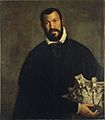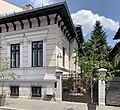Corinthian order facts for kids
The Corinthian order is a special style of building design from ancient Greece and Rome. It's one of the three main "classical orders" of architecture, along with the Doric order and Ionic order.
The Corinthian style is known for being the most fancy and decorative. Its columns are usually thin and have vertical lines, called flutes, running up their sides. The most unique part is the large top section of the column, called the capital. This capital is beautifully decorated with carved leaves, usually from the acanthus plant, and small scrolls.
Contents
History of the Corinthian Order
The Corinthian order first appeared in ancient Greece. The oldest known example of a Corinthian column is found inside the Temple of Apollo Epicurius at Bassae. This temple was built around 450 to 420 BC. This early column was used inside the building, not on its outer walls.
The first time the Corinthian order was used on the outside of a building was on the round Choragic Monument of Lysicrates in Athens. This monument was built around 334 BC. Over time, the Romans really liked the Corinthian style and used it a lot in their own buildings.
Famous Buildings with Corinthian Columns
Many famous buildings around the world use the Corinthian order. Here are some examples:
In Ancient Greece
- Choragic Monument of Lysicrates, Athens
- Temple of Olympian Zeus (Athens)
In Ancient Rome
- Pantheon, Rome (This building is a great example!)
- Temple of Mars Ultor
Later Styles: Renaissance and Beyond
The Corinthian order became popular again much later during the Renaissance and Baroque periods. It was also used a lot in Neoclassical and Beaux-Arts buildings, especially in the 18th and 19th centuries.
Modern Examples
- United States Capitol (You can see it in illustrations of this building!)
- St. La Salle Hall, Manila
- Don Enrique T. Yuchengco Hall, Manila
- Enrique M. Razon Sports Center, Manila
- Great Lavra Belltower in Ukraine (Look for 8 columns on its fourth level!)
- The Reichstag in Berlin, Germany
Related pages
- Classical order
- Doric order
- Ionic order
- Tuscan order
- Composite order
Images for kids
-
A Corinthian capital from the Pantheon, Rome, which provided a prominent model for Renaissance and later architects
-
Corinthinan peripteros of the Temple of Bacchus in Baalbek, Lebanon
-
Corinthian columns of the Arch of Septimius Severus, in the Forum Romanum
-
Figure of the Buddha, within a Corinthian capital, Gandhara, 3–4th century, Musee Guimet.
-
Vincenzo Scamozzi offers his version of the Corinthian capital, in a portrait by Veronese (Denver Art Museum)
-
Ancient Greek capital from Tarentum with addorsed sphinxes, 4th–3rd centuries BC, made of limestone, in the Metropolitan Museum of Art (New York City)
-
The origin of the Corinthian order, illustrated in Claude Perrault's translation of the ten books of Vitruvius, 1684
-
The Maison Carrée in Nîmes, France, built in circa 14 BC
-
The Corinthian order as used in extending the United States Capitol in 1854: the column's shaft has been omitted
-
The Constantinian basilica of Santa Sabina interior, with spolia Corinthian columns from the Temple of Juno Regina.
-
Hadrian's Library on the north side of the Acropolis of Athens, created by Roman Emperor Hadrian in 132 AD
-
Feast in the House of Levi, by Paolo Veronese, from 1573. In the background appear many Corinthian columns
-
Illustrations of Corinthian pilasters, from Germany, in the Cooper Hewitt, Smithsonian Design Museum from New York City
-
The Temple of Love in the gardens of the Petit Trianon at the Gardens of Versailles in Versailles (France)
-
Corinthian pilaster capital in the Cathédrale Saint-Louis des Invalides (Paris)
-
The fake Roman ruins from the gardens of the Schönbrunn Palace (Austria), built in 1778 and based on Giovanni Battista Piranesi's depictions of the Roman Temple of Vespasian and Titus
See also
 In Spanish: Orden corintio para niños
In Spanish: Orden corintio para niños
































